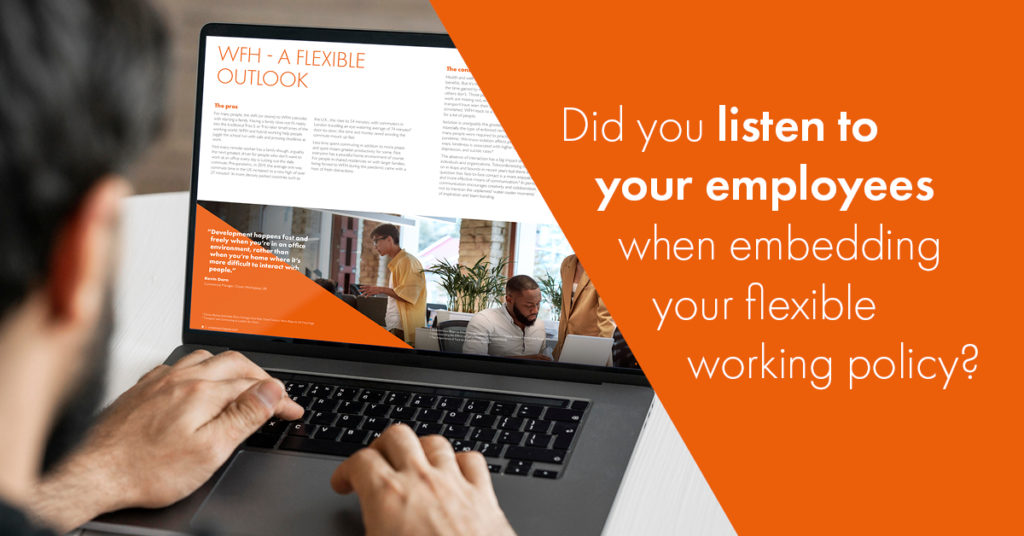What to consider when making the big decision on where your employees will work
As an employer, it’s likely you’re deciding where your employees will be working in the coming years: home, office, or a hybrid of both? Introducing new working styles is a task you need to get right.
The past few years have seen the intensifying adoption of all sorts of working models and the changing in business trends: office downsizing is one we’ve spoken about before, for example.
Why is it important to get it right?
From the moment you roll out the policy to staff, it needs to be right. The process could be expensive, extremely time consuming and disruptive for employees. It’s important to plan every detail, consider all costs including financial costs, cost to employees, clients and customers and more.
In this article, we spoke with Workspace specialists to explore things to consider when making the big decision:
Listening to your employees

Whatever path you take, even if it’s maintaining five-days a week in the office, listening to your people is crucial.
What does this mean?
An important aspect of ensuring people buy into a company vision is ensuring they have input in that vision. The modern, progressive, organization is not a top-down dictatorship. It is not a democracy either, it is, ideally, a meritocracy where the best ideas rise to the top. When it comes to those ideas, don’t allow room for guesswork – see what your employees think by running questionnaires or focus groups.
When decisions get taken at the top, you need to ensure your HR, finance and operations leads can communicate the benefits of that vision. Not just the business benefits, but the benefits that employees will reap. You can’t please all people, all the time. The good news is you don’t need to, to thrive as a business.
Creating a collaborative environment
“Employees still enjoy the office environment. Face-to-Face human interaction and collaboration (not via technology) is the main driver. Being part of a team with physical/face to face interaction with colleagues and clients still preferred for employees in most roles”
– Andrew Fullerton Smith, General Manger Sales, CrownFIL Workspace, New Zealand
Bringing people into a shared environment helps create closer bonds. It supports a company culture of “one for all and all for one”. There are more opportunities to learn from others, greater exposure to senior leaders, and more mentoring opportunities – all of which benefit the individuals and the organization overall. Future leaders, and their leadership styles, can be more easily observed and assessed as a company builds its succession plan.
On the topic of welcoming in the next generation of employees embarking on the first steps of the next phase of their lives, we can’t ignore the social aspect of what makes a great employer, which is an integral part of an organization’s culture. This is especially relevant for younger generations for whom work/life balance does not necessarily mean work and family life.
Younger workers value mentorship and the bonds they build with co-workers. In one survey of Gen Zs the percentage who said those connections were ‘very important’ increased from 59% to 81% after just six months of the pandemic. This underscores the paradigm shift Covid has played in shaping generational expectations around work.
Being able to offer an attractive shared facility works for recruitment and retention. We knew the value of this pre-pandemic. At the dawn of the current century, we witnessed a shift from drab interior design and a cubicle farm layout to more open, modern and vibrant office environments pioneered by Silicon Valley start-ups. That doesn’t mean your office needs beanbags and table tennis, but likewise it should not be entirely utilitarian.
There’s more to think about…
The way we work has changed. But where are we going?
Our latest whitepaper: Tomorrow’s Workspaces Today explores the question in detail. We’ve spoken to a range of experts across the world, from different parts of the business world to share an informed view on what the future workplace will look like, the pros and cons of the different working models and the impact your decision can have.
Download our whitepaper: Tomorrow’s Workspaces Today – Building a Flexible Future Together to understand what you need to consider, the impact your decision can have and expert driven predictions for the future.
Related stories
For many organizations, your office is seen as a cost of doing business. Rent, furniture, fixtures and equipment are written off over time and eventually replaced. But what if we started treating offices differently? What if we viewed them as assets that can hold value, adapt to change and contribute to long-term resilience? This shift […]
Walk into modern offices and you’ll see the motifs of sustainability: a living wall in reception, branded reusable mugs in the pantry, perhaps even a rooftop beehive. These are the sort of things that photograph well and tick boxes in annual reports. But what truly makes an office “green”? The uncomfortable truth is that many […]
Sustainability is everywhere in workplace design. From rooftop gardens to recycled coffee cups, offices are quick to showcase their “green” credentials. But how much of this activity delivers genuine environmental impact, and how much is simply optics?





























